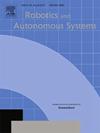Evaluating the influence of UEXO-II on human performance: A torque and muscle level analysis
IF 4.3
2区 计算机科学
Q1 AUTOMATION & CONTROL SYSTEMS
引用次数: 0
Abstract
Despite the increasing prevalence of exoskeleton technology, the lack of standardized evaluation methods poses significant challenges. This study aims to comprehensively generate direct dynamic evaluation indicators regarding the impact of the UEXO-II exoskeleton technology on human performance, with a focus on both torque and muscle levels. By inverse dynamics analysis based on identified parameters and optimization-based muscle force estimation techniques, we directly elucidate the effects of exoskeleton on human joint torque generation and muscle force exertion. Furthermore, this study investigates the influence of variations in motion frequency and exoskeleton controller parameters on human performance outcomes through statistical analysis at both torque and muscle levels. This contributes to the discussion on the optimal control of exoskeletons for movements at different frequencies. Results of this study indicate that both joint torque and muscle force varies, with some phases of the motion sequence being laborious and others being effortless, following exoskeleton utilization. Notably, the motion frequency and parameters of the exoskeleton controller emerge as influential factors, significantly impacting human energy consumption and muscular strength both under without and with exoskeleton conditions. This study holds promise as an effective method for evaluating performance of UEXO-II.
评估UEXO-II对人体性能的影响:扭矩和肌肉水平分析
尽管外骨骼技术日益普及,但缺乏标准化的评估方法带来了重大挑战。本研究旨在综合生成UEXO-II外骨骼技术对人体性能影响的直接动态评价指标,重点关注扭矩和肌肉水平。通过基于识别参数的逆动力学分析和基于优化的肌肉力估计技术,我们直接阐明了外骨骼对人体关节扭矩产生和肌肉力消耗的影响。此外,本研究通过扭矩和肌肉水平的统计分析,探讨了运动频率和外骨骼控制器参数的变化对人类表现结果的影响。这有助于讨论外骨骼在不同频率下运动的最佳控制。这项研究的结果表明,关节扭矩和肌肉力都是不同的,随着外骨骼的使用,运动序列的某些阶段是费力的,而其他阶段则是毫不费力的。值得注意的是,外骨骼控制器的运动频率和参数成为影响因素,在无外骨骼和有外骨骼的情况下,对人体能量消耗和肌肉力量都有显著影响。该研究有望成为评价UEXO-II性能的有效方法。
本文章由计算机程序翻译,如有差异,请以英文原文为准。
求助全文
约1分钟内获得全文
求助全文
来源期刊

Robotics and Autonomous Systems
工程技术-机器人学
CiteScore
9.00
自引率
7.00%
发文量
164
审稿时长
4.5 months
期刊介绍:
Robotics and Autonomous Systems will carry articles describing fundamental developments in the field of robotics, with special emphasis on autonomous systems. An important goal of this journal is to extend the state of the art in both symbolic and sensory based robot control and learning in the context of autonomous systems.
Robotics and Autonomous Systems will carry articles on the theoretical, computational and experimental aspects of autonomous systems, or modules of such systems.
 求助内容:
求助内容: 应助结果提醒方式:
应助结果提醒方式:


